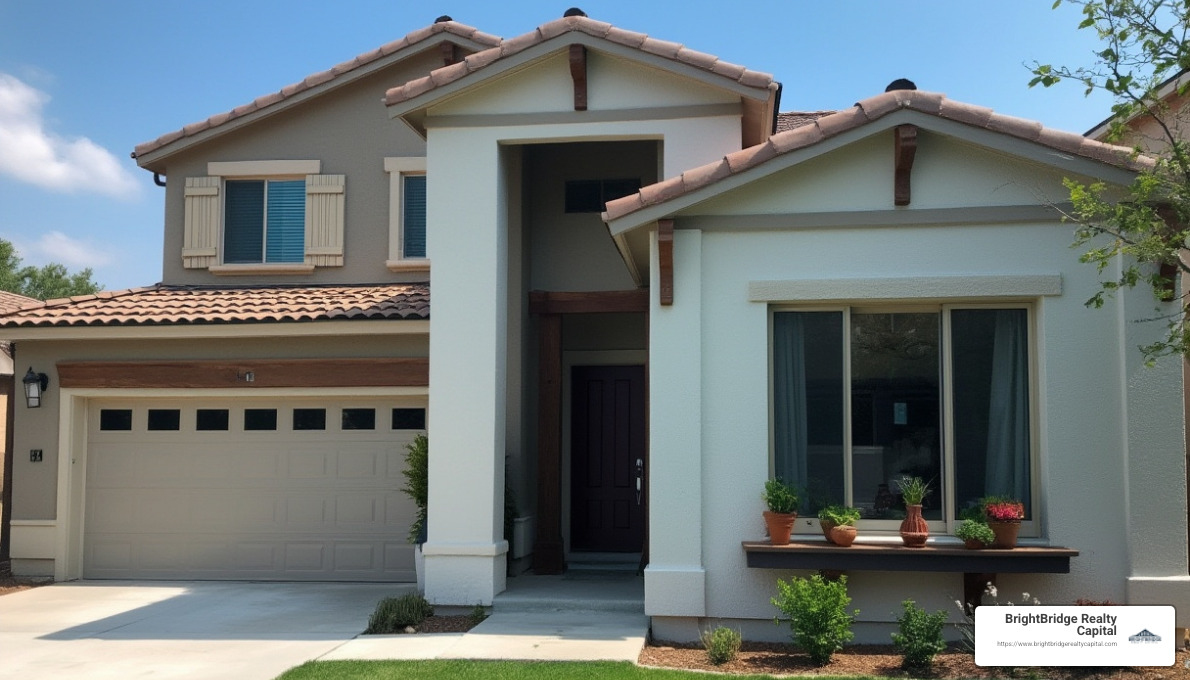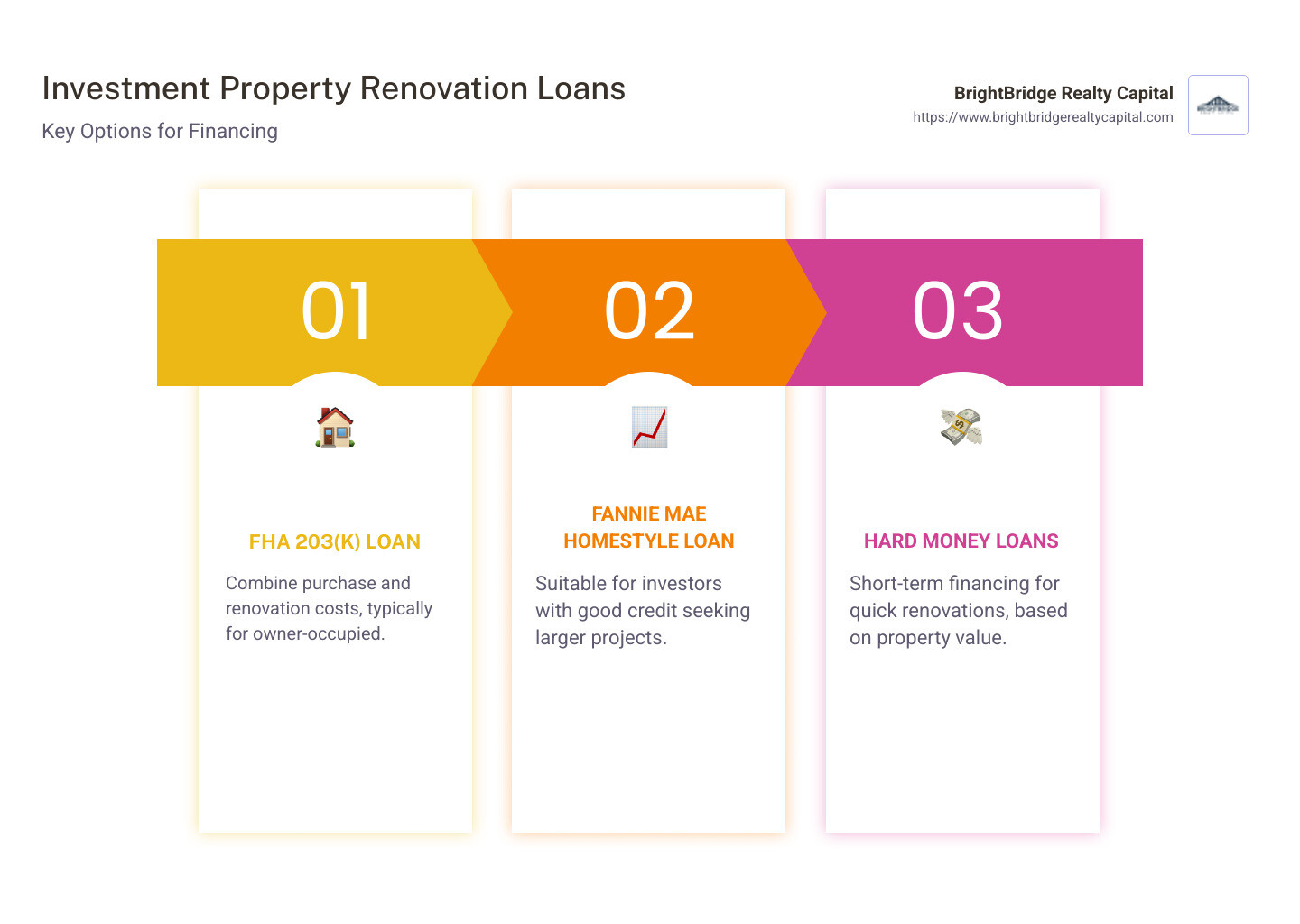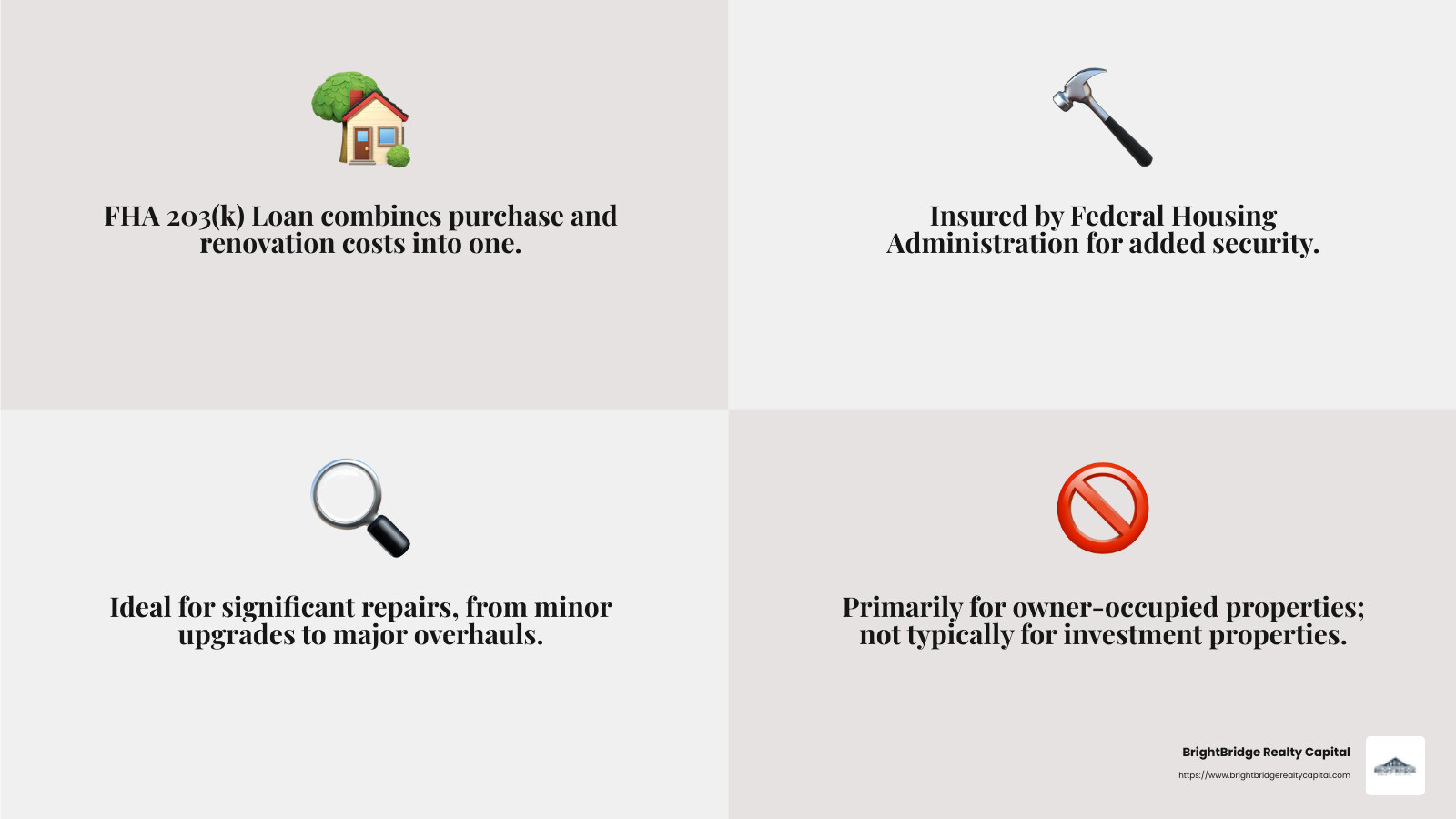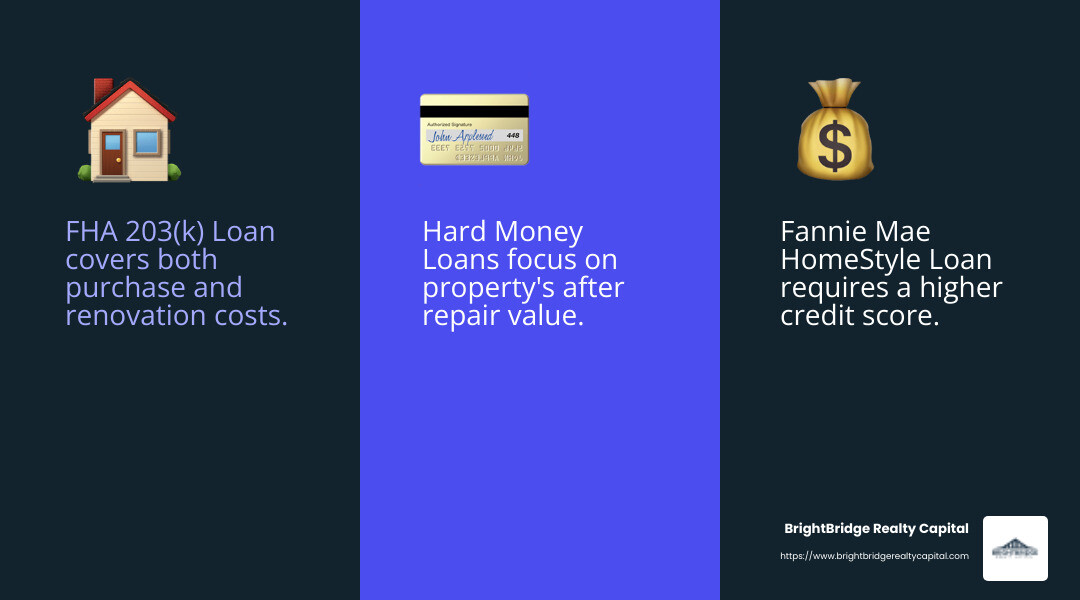Renovate and Reap: A Comprehensive Guide to Investment Property Loans

Are you searching for a loan to renovate investment property? Here's a quick breakdown:
- FHA 203(k) Loan: Ideal for combining purchase and renovation costs, but typically for owner-occupied properties.
- Fannie Mae HomeStyle Loan: Suitable for investors with good credit seeking larger projects.
- Hard Money Loans: Best for quick renovations with high interest, focused on property value.
In real estate investment, finding the right financing is crucial for changing properties into profitable ventures. Whether you're flipping a fixer-upper or enhancing rental portfolios, a loan to renovate investment property can open up potential profits and value.
Real estate investors, especially in markets like New York, need access to quick and flexible renovation loans that can keep up with market demands. With options ranging from government-backed loans to hard money solutions, investors have multiple pathways to turn real estate dreams into reality.
Explore renovation loans crafted specifically for investment properties, understand the financing options available, and maximize your property’s post-renovation value. By leveraging the right loan, you can ensure a seamless process and achieve the desired return on investment.

Key loan to renovate investment property vocabulary:
- home equity loans on investment properties
- refinancing investment property loan
- investment property loans with no down payment
Understanding Investment Property Loans
Navigating investment property loans can feel overwhelming. But understanding your options is key to making the most of your real estate investments. Let's break down three popular loan types that can help you finance your next renovation project.
FHA 203(k) Loan
The FHA 203(k) Loan is a government-backed option that combines the costs of purchasing and renovating a property into one loan. It's like getting a mortgage and a construction loan all in one package. This loan is insured by the Federal Housing Administration, which makes lenders more willing to offer it even for properties that need significant repairs.
However, the FHA 203(k) is primarily for owner-occupied homes, which means it's not typically available for investment properties. But if you're planning to live in the property while fixing it up, this could be a great option. The loan covers a wide range of renovations, from minor repairs to major overhauls, making it a versatile choice for those eligible to use it.

Fannie Mae HomeStyle Loan
For investors who need a bit more flexibility, the Fannie Mae HomeStyle Loan is a strong contender. Unlike the FHA 203(k), this loan isn't limited to owner-occupied properties, making it a viable option for investment properties. It's perfect for those with good credit who are looking to finance larger renovation projects.
The HomeStyle loan can be used to cover both purchase and renovation costs, similar to the FHA 203(k). However, it comes with stricter credit requirements. Borrowers typically need a higher credit score to qualify, but the benefits include potentially lower interest rates and the ability to fund a broader range of improvements.
Hard Money Loans
When time is of the essence, Hard Money Loans offer a quick solution. These loans are provided by private lenders and are ideal for investors looking to renovate and sell properties quickly. They focus more on the property's value rather than the borrower's credit score, making them accessible for those who may not qualify for traditional loans.
Hard money loans are short-term and come with higher interest rates, but they provide fast funding, often within days. This can be crucial in competitive markets where speed is essential. The loan amount is typically based on the property's after repair value (ARV), allowing investors to leverage the potential increase in property value post-renovation.

In summary, choosing the right loan depends on your specific needs and circumstances. Whether it's a government-insured option like the FHA 203(k), a flexible choice like the Fannie Mae HomeStyle, or the speed of hard money loans, understanding these options can help you make informed decisions and maximize your investment property's potential.
Loan to Renovate Investment Property
When it comes to renovating investment properties, choosing the right loan to renovate investment property can significantly impact your financial success. Two notable options are Non-Owner Occupied Renovation Loans and RenoFi Loans. Each offers unique advantages that can help you leverage financing strategies to maximize your property's value.
Non-Owner Occupied Renovation Loans
Non-Owner Occupied Renovation Loans are designed specifically for investors who do not live in the property they are renovating. These loans are particularly beneficial because they are based on the property's after repair value (ARV). This means the loan amount is determined by the estimated value of the property after renovations are complete, allowing investors to borrow more than they might with other loan types.
LTV Ratio: These loans often provide up to 80% of the ARV. For instance, if the renovated property is appraised at $200,000, you could potentially borrow up to $160,000. This flexibility allows you to cover both the purchase and renovation costs.
Property Improvements: It's crucial that the renovations add real value to the property. Cosmetic changes might not suffice. Focus on improvements that improve the property's overall value, such as new plumbing or a modernized kitchen.
Non-owner occupied renovation loans offer a strategic way to boost your investment property's value without needing to reside there. They enable you to transform a fixer-upper into a high-yield asset, all while maximizing your borrowing capacity.
RenoFi Loans
RenoFi Loans are another excellent option, especially for investors who are keen on leveraging the future value of their properties. These loans consider the renovation potential and allow you to borrow based on the increased value post-renovation.
Future Value: RenoFi Loans focus on what your property will be worth after the upgrades. This approach can significantly increase your borrowing capacity, giving you the financial leverage to undertake substantial renovations.
Renovation Potential: By evaluating the potential improvements, RenoFi Loans help you open up the full value of your property. This can be particularly advantageous for recent acquisitions with limited equity, as it allows you to invest in high-impact renovations that could significantly increase property value.
RenoFi Loans provide a path to strategically improve the worth of your investment property. By focusing on future value, they enable you to undertake ambitious projects that maximize your property's appeal and profitability.
Both Non-Owner Occupied Renovation Loans and RenoFi Loans offer robust financing strategies for investors looking to renovate and reap the benefits. By understanding these options, you can effectively leverage loans to maximize the value of your real estate investments.
Next, we'll explore how to steer the loan approval process, ensuring you're well-prepared to secure the financing you need.
Navigating the Loan Approval Process
Securing a loan to renovate investment property involves understanding several key components. These include creditworthiness, appraisals, and necessary documentation. Let's explore these critical aspects to help you successfully steer the loan approval process.
Importance of ARV
The After Repair Value (ARV) is a crucial factor in securing a renovation loan. This value represents what your property will be worth after all planned renovations are complete. Lenders use the ARV to determine the loan amount they are willing to offer.
Property Appraisal: Before granting a loan, lenders require a professional appraisal to estimate the ARV. This appraisal assesses the potential impact of your renovations on the property's future value. It's important to have a detailed renovation plan to support this appraisal.
Loan Amount: The ARV directly influences the loan amount a lender will approve. Typically, lenders offer a percentage of the ARV, often up to 80%. For example, if the ARV is $250,000, you could secure a loan of up to $200,000.
Understanding the ARV and its role in the loan process can significantly improve your chances of securing the necessary funds for your renovation project.
Local Regulations and Compliance
Compliance with local regulations is another vital step in the loan approval process. Failing to adhere to zoning laws and inspection requirements can delay or even derail your renovation plans.
Zoning Laws: Before starting renovations, ensure that your plans comply with local zoning laws. These laws dictate what changes can be made to the property, such as adding new structures or altering existing ones.
Inspections: Many lenders require periodic inspections during the renovation process. These inspections ensure that the work aligns with the agreed-upon renovation plan. For instance, VA renovation loans often involve inspections to release funds at different project milestones.
Renovation Plans: A comprehensive renovation plan is essential. It should outline all intended improvements and their expected impact on property value. This plan not only aids in the appraisal process but also helps ensure compliance with local regulations.
By understanding and preparing for these aspects, you can streamline the loan approval process. This preparation increases the likelihood of securing the financing needed to transform your investment property into a profitable asset.
Next, we'll address some frequently asked questions about investment property loans to further clarify your financing options.
Frequently Asked Questions about Investment Property Loans
What is the best loan for renovating an investment property?
Choosing the right loan to renovate an investment property depends on your specific needs and financial situation. Here are a few options to consider:
FHA 203(k) Loan: Ideal for those looking to combine purchase and renovation costs. It's government-insured but primarily for owner-occupied homes. However, investors might use it for rental properties if they meet certain criteria.
Fannie Mae HomeStyle Loan: This is a versatile option for those with good credit. It allows financing for larger renovation projects and isn't restricted to owner-occupied properties.
Hard Money Loans: Short-term financing is best for quick renovations and flips. These loans focus on the property's value rather than the borrower's credit score but come with higher interest rates.
Each loan has its pros and cons, so evaluate your project's scope and your financial standing to determine the best fit.
How do I qualify for a renovation loan?
Qualifying for a renovation loan involves several key factors:
Credit Score: A solid credit score is crucial. For instance, a Fannie Mae HomeStyle loan typically requires a score of at least 620, while FHA 203(k) loans might accept scores as low as 500. Hard money lenders may be more lenient, focusing on the property's value instead.
Income Verification: Lenders need proof of steady income to ensure you can repay the loan. This might include pay stubs, tax returns, or bank statements.
Real Estate Experience: Some loans, like hard money loans, might favor borrowers with a track record of successful real estate investments.
Loan-to-Value (LTV) Ratio: Lenders assess the LTV ratio, comparing the loan amount to the property's current value. A lower ratio often means better loan terms.
Meeting these requirements increases your chances of securing a renovation loan.
Can I use a renovation loan for rental properties?
Yes, you can use a renovation loan for rental properties. Here are some financing options:
HomeStyle Loan: Suitable for investment properties, allowing you to finance renovations while benefiting from competitive interest rates.
RenoFi Loans: These consider the property's future value, making it easier to borrow against the expected increase in value post-renovation.
Bridge Loans: These provide short-term financing, ideal for purchasing and renovating rental properties quickly.
When choosing a loan, consider how the renovation will impact rental income and property value. This ensures the loan aligns with your investment goals and maximizes potential returns.
Next, we'll conclude with how BrightBridge Realty Capital offers customized solutions for your investment property needs.
Conclusion
At BrightBridge Realty Capital, we know that every real estate investment is unique. That's why we offer customized solutions custom to meet the diverse needs of investors. Whether you're looking to flip a property or improve your rental portfolio, our team is here to help you find the right financing strategy.
One of our standout features is our ability to provide fast closings, often within a week. This speed can be a game-changer in the competitive real estate market, allowing you to seize opportunities as soon as they arise. Our direct lending approach eliminates intermediaries, ensuring you receive competitive rates and a seamless process from start to finish.
Choosing the right loan to renovate an investment property can significantly improve its value and boost your returns. With our expertise and flexible financing options, you can confidently steer the complexities of property renovation and investment.
Explore how we can assist you in achieving your investment goals with our custom real estate financing solutions. Learn more about BrightBridge Realty Capital's offerings and take the next step in your investment journey today.


